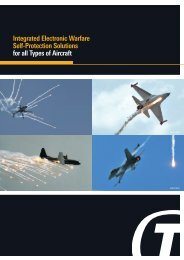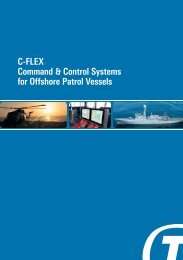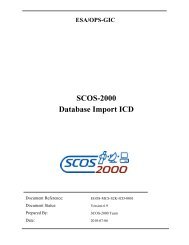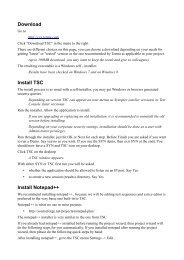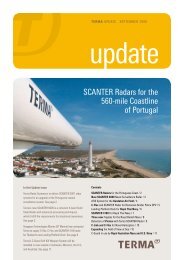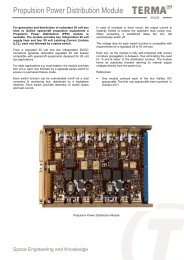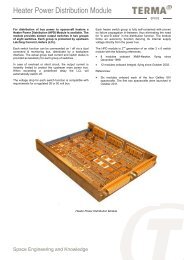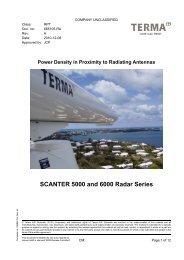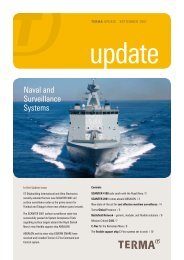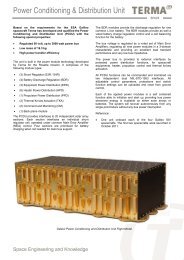Small target detection from the Next Generation SCANTER ... - terma
Small target detection from the Next Generation SCANTER ... - terma
Small target detection from the Next Generation SCANTER ... - terma
You also want an ePaper? Increase the reach of your titles
YUMPU automatically turns print PDFs into web optimized ePapers that Google loves.
<strong>Small</strong> <strong>target</strong> <strong>detection</strong> <strong>from</strong> <strong>the</strong> <strong>Next</strong> <strong>Generation</strong> <strong>SCANTER</strong> 5000<br />
and 6000 Series of radars <strong>from</strong> Terma A/S<br />
By Jens Chr. Pedersen, Director, Product Portfolio & Innovation, Radar Systems, Terma A/S<br />
The <strong>SCANTER</strong> 5000 series comprises a new generation of Fully Coherent, Frequency<br />
Diversity and Time Diversity, Solid State Radars with Software Defined Functionality for<br />
professional applications such as VTS, Coastal Surveillance and Airport Surface Movement<br />
Radars (SMR). Similar technology is employed in <strong>the</strong> <strong>SCANTER</strong> 6000 series of<br />
radars for Ship-borne applications.<br />
Several tests with <strong>target</strong>s of opportunity as well as controlled tests were made during <strong>the</strong><br />
development. This was complemented with a repeated series of trials made during release<br />
for operational use of <strong>the</strong> <strong>SCANTER</strong> 5102 transceiver in June 2010.<br />
Fur<strong>the</strong>rmore, <strong>the</strong> performance was compared to a <strong>SCANTER</strong> 2001 FD transceiver installed<br />
next to <strong>the</strong> <strong>SCANTER</strong> 5102, utilising <strong>the</strong> same 21’HP-F-38 antenna. Both transceivers<br />
were configured for stationary surface surveillance applications. The <strong>SCANTER</strong><br />
2001 includes two 25 KW magnetron amplifiers. The <strong>SCANTER</strong> 5102 is fitted with a 50<br />
W Solid State Power amplifier.<br />
The tests were made at <strong>the</strong> Terma HQ test range, and with <strong>target</strong>s sailing in <strong>the</strong> bay of<br />
Aarhus.<br />
Figure 1: Radar image <strong>from</strong> <strong>the</strong> <strong>SCANTER</strong> 5102 at <strong>the</strong> Terma test site<br />
A 5.2 meter zodiac with outboard motor was used for verification test of <strong>the</strong> performance.<br />
The Radar Cross section was measured to 1.4 square meters and <strong>the</strong> estimated<br />
Updated 18/8 2010, recent information about ASPECT added 1/4
center of gravidity for <strong>the</strong> RCS is 0.5 m ASL, with <strong>the</strong> boat driver sitting up. Speed during<br />
<strong>the</strong> tests was varying between 0 and 30 knots, without significant influence on <strong>the</strong> results.<br />
A floating, calibrated reference reflector was placed in <strong>the</strong> test area at a distance<br />
of approximately 4 nautical miles.<br />
Figure 2 Target used for controlled tests.<br />
Figure 3 2 m 2 reference reflector used for measurement of <strong>target</strong> Radar Cross<br />
Section during <strong>the</strong> tests.<br />
The CARPET program <strong>from</strong> TNO was used to calculate expected range performance,<br />
taking actual wea<strong>the</strong>r into consideration. Very different wea<strong>the</strong>r situations appeared.<br />
On 07/06/2010 it was very dense rainfall; approximately 50 millimeters of rainfall<br />
were recorded during daytime on nearby meteorological stations. The rainfall<br />
during <strong>the</strong> test was estimated to 5 mm/hour, fairly uniform over <strong>the</strong> entire area.<br />
On 10/06/2010 it was less dense rainfall; approximately 20-25 millimeters of rainfall<br />
were recorded during daytime on nearby meteorological stations. The rainfall<br />
during <strong>the</strong> test was estimated to 2 mm/hour, not as uniform as on <strong>the</strong> first day<br />
and with cells of dense shower like rain.<br />
Updated 18/8 2010, recent information about ASPECT added 2/4
On 16/06/2010 it was clear sunny wea<strong>the</strong>r with a mild breeze.<br />
The rain during <strong>the</strong> first 2 days was completely removed by processing resulting in an as<br />
clear image as on <strong>the</strong> day with clear wea<strong>the</strong>r.<br />
Most of <strong>the</strong> range between <strong>the</strong> radar and <strong>the</strong> test area is over land. Evaporation ducting<br />
will in such case only have marginal effect on <strong>the</strong> propagation and standard atmospheric<br />
conditions.<br />
Antenna height at <strong>the</strong> Terma test site is approximately 50 meters ASL and <strong>the</strong><br />
waveguide length between <strong>the</strong> antenna and <strong>the</strong> transceivers is 22 meters<br />
Calculation and test results are summarized in Table 1.<br />
Table 1 Calculation and test results.<br />
Date of test<br />
Conditions<br />
Calculated <strong>detection</strong> range with<br />
used Radar setup, 99% Pd<br />
<strong>SCANTER</strong><br />
2001 FD<br />
<strong>SCANTER</strong><br />
5102<br />
<strong>SCANTER</strong><br />
5202<br />
Measured <strong>detection</strong> range @ first<br />
loss of <strong>detection</strong><br />
<strong>SCANTER</strong><br />
2001 FD<br />
<strong>SCANTER</strong><br />
5102<br />
<strong>SCANTER</strong><br />
5202<br />
07/06/2010<br />
10/06/2010<br />
Aproximately 5<br />
mm/h rain, Sea<br />
state 1-2<br />
Aproximately 2<br />
mm/h rain, Sea<br />
state 1-2<br />
3.7 nmi 4.0 nmi 4.2 nmi 4 nmi 5.7 nmi<br />
4.2 nmi 4.4 nmi 4.7 nmi 5.6 nmi 6.5 nmi<br />
Not<br />
included<br />
in test<br />
16/06/2010<br />
Clear, light breeze,<br />
Sea state 2<br />
6.0 nmi 5.6 nmi 6.2 nmi 6.5 nmi 7.8 nmi<br />
The difference between calculated and measured results for <strong>the</strong> <strong>SCANTER</strong> 2001 is in<br />
accordance with typical experience, <strong>the</strong> CARPET calculations are a bit pessimistic.<br />
We have by now observed that <strong>the</strong> <strong>Next</strong> <strong>Generation</strong> radar technology is performing substantially<br />
better than expected. The main reason for that is most likely that <strong>the</strong> empiric<br />
models behind <strong>the</strong> CARPET tools are insufficient in respect to modeling of <strong>the</strong> new series<br />
of <strong>SCANTER</strong> radars. Looking at <strong>the</strong> radar screen, <strong>target</strong> fluctuations are much reduced<br />
with <strong>the</strong> new technology and this does explain most of <strong>the</strong> excess performance.<br />
Fur<strong>the</strong>rmore, <strong>the</strong> differences seem to appear in all wea<strong>the</strong>r conditions. However, tests<br />
with high sea clutter conditions are yet to be completed. In <strong>the</strong> meantime, evidence is<br />
sufficient to allow use of CARPET with <strong>SCANTER</strong> 2001 FD parameters to determine<br />
performance for <strong>the</strong> 50 W versions, <strong>SCANTER</strong> 5102 and 5502, of <strong>the</strong> <strong>Next</strong> <strong>Generation</strong><br />
radars in respect to surface <strong>target</strong> <strong>detection</strong>.<br />
In respect to <strong>the</strong> 200W versions, <strong>SCANTER</strong> 5202, 5602 and 6002, it is OK to calculate<br />
with 5% increased range (20% increased volume) when compared to <strong>SCANTER</strong> 2001.<br />
However, BE CAREFULL, <strong>the</strong> horizon (lowest lobe) may be <strong>the</strong> limiting factor, in which<br />
cases <strong>the</strong> range performance is identical. This counts especially for low antenna elevations<br />
and in clear wea<strong>the</strong>r without ducting.<br />
It is in any case better to use <strong>the</strong> new Terma performance evaluation Tool, ASPECT, it<br />
does include better modeling of <strong>the</strong> new radars and it is being fur<strong>the</strong>r refined as experience<br />
with <strong>the</strong> new products is gained.<br />
Updated 18/8 2010, recent information about ASPECT added 3/4
Figure 4 Test <strong>target</strong> at 6.1 and 7.4 Nautical Miles respectively<br />
Updated 18/8 2010, recent information about ASPECT added 4/4



